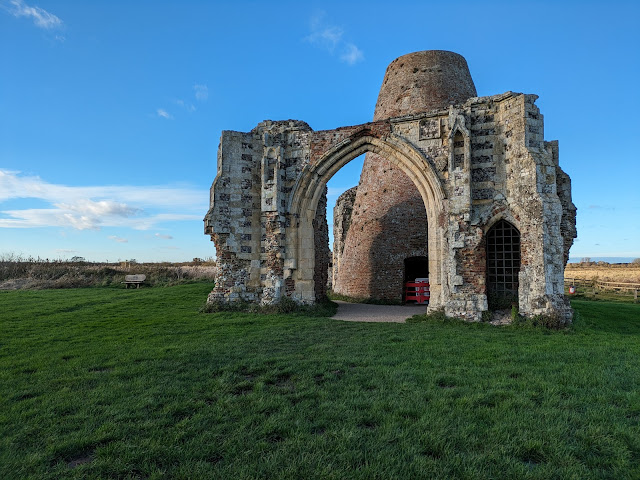St.Ninian, Whithorn and the Ruthwell Cross
When Ted (Ted Heasley RIP) and I visited the Isle of Whithorn back in 2000 AD the Cairn of Witness was new. We liked the idea but we hadn't known about it, otherwise we would have brought a piece of East Anglian flint to place on the pile!
In 20015 it was still on my to do list.
So last month when I returned, a piece of Norfolk flint was added and I had a minute or two remembering Ted.
Back then we were on our way to Headford in County Galway - a pilgrimage made in honour of St. Fursey - it all seemed cut and dried. But now scholars find it hard to agree on where St. Fursey had his monastic formation. It may have been just a short hop across the Irish Sea in Ulster.
Ted and I had called in at Whithorn where we visited the site of St. Ninian's , Candida Casa (White Shining perhaps? House ) the pilgrimage chapel at the Isle of Whithorn and Ninian's Cave. In my mind it had been a detour but now I see differently.
Most of what we know about Ninian is from the Ven. Bede who probably gave him a good press because that part of Scotland was, in his day, part of the Kingdom Northumberland. Scholars struggle to link Ninian with saints found in Irish sources. Its possible that Bede's Ninian, around whom a hagiography was written in the Middle Ages, is none other than Finnian of Moville. Finnian it is who taught St. Columba. In which case, Whithorn before Iona works really well.
From the mouth of Ninian's cave one can view both the Isle of Man and the Lake District. From Kyle of Galloway the Ulster coast is clear. So whatever success the scholars achieve or fail to achieve this whole area full of echoes of the Christian past. Patrick, Ninian/Finnian, Columba and Fursey (perhaps?) . The archaeology confirms a sea route, what amounts to a 5th century motorway, linking Gaul, Cornwall, Wales, western Britain and the Irish east coast.
So perhaps it is not so far fetched to imagine Fursey and his companions passing through Whithorn on their way to evangelise Norfolk. Did their path lead cross country to the Northumberland coast and then down by boats to Norfolk? Oswald became king in in 634 so he may have provided safe passage! Or did they come via Irish monasteries on the European Continent? St. Felix who began the evangelisation of East Anglia had come from Francia!
Whatever, it was good to reach out my hand and touch a 5th memorial stone in the Whithorn Museum and to wonder at the 7th century Ruthwell Cross. There's something very tangible about stones.
Don't let anyone sell the Ruthwell Cross to you as Celtic. Ruthwell may be in Scotland today. Then it was in the Anglian Kingdom Of Northhumberland.
I'm sure if we had a bit more useful stone we'd have lots of these crosses in Norfolk. As it is we have flint!
I placed a piece of flint on the Cairn of Witness both a marker of an act of witness completed and a pledge for more to come.
So last month when I returned, a piece of Norfolk flint was added and I had a minute or two remembering Ted.
Back then we were on our way to Headford in County Galway - a pilgrimage made in honour of St. Fursey - it all seemed cut and dried. But now scholars find it hard to agree on where St. Fursey had his monastic formation. It may have been just a short hop across the Irish Sea in Ulster.
Most of what we know about Ninian is from the Ven. Bede who probably gave him a good press because that part of Scotland was, in his day, part of the Kingdom Northumberland. Scholars struggle to link Ninian with saints found in Irish sources. Its possible that Bede's Ninian, around whom a hagiography was written in the Middle Ages, is none other than Finnian of Moville. Finnian it is who taught St. Columba. In which case, Whithorn before Iona works really well.
From the mouth of Ninian's cave one can view both the Isle of Man and the Lake District. From Kyle of Galloway the Ulster coast is clear. So whatever success the scholars achieve or fail to achieve this whole area full of echoes of the Christian past. Patrick, Ninian/Finnian, Columba and Fursey (perhaps?) . The archaeology confirms a sea route, what amounts to a 5th century motorway, linking Gaul, Cornwall, Wales, western Britain and the Irish east coast.
So perhaps it is not so far fetched to imagine Fursey and his companions passing through Whithorn on their way to evangelise Norfolk. Did their path lead cross country to the Northumberland coast and then down by boats to Norfolk? Oswald became king in in 634 so he may have provided safe passage! Or did they come via Irish monasteries on the European Continent? St. Felix who began the evangelisation of East Anglia had come from Francia!
Don't let anyone sell the Ruthwell Cross to you as Celtic. Ruthwell may be in Scotland today. Then it was in the Anglian Kingdom Of Northhumberland.
I'm sure if we had a bit more useful stone we'd have lots of these crosses in Norfolk. As it is we have flint!
I placed a piece of flint on the Cairn of Witness both a marker of an act of witness completed and a pledge for more to come.









Comments